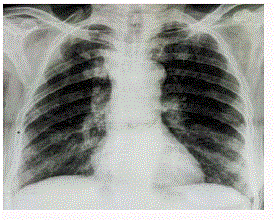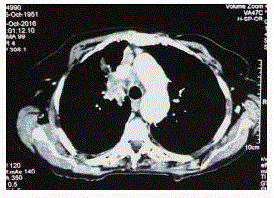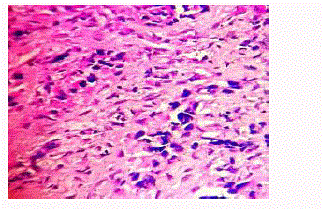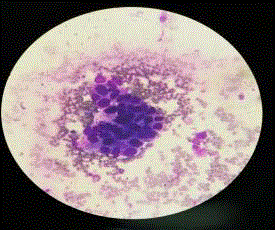Case Report
Isolated Hypoglossal Nerve Palsy in a Patient with Non-Small Cell Lung Carcinoma: A Rare Paraneoplastic Neurological Syndrome
Himanshu Juneja1*, Surekha Dabla2, Manoj Yadav1, Isha Pahuja1, Surender Kumar1 and Pradyumna Kumar Singh1
1Department of General Medicine, Pandit Bhagwat Dayal Sharma Post Graduate Institute of Medical Sciences,
India
2Department of Neurology, Pandit Bhagwat Dayal Sharma Post Graduate Institute of Medical Sciences, India
*Corresponding author: Himanshu Juneja, Department of General Medicine, Pandit Bhagwat Dayal Sharma Post Graduate Institute of Medical Sciences, Haryana, India
Published: 24 Oct, 2017
Cite this article as: Juneja H, Dabla S, Yadav M, Pahuja
I, Kumar S, Singh PK. Isolated
Hypoglossal Nerve Palsy in a Patient
with Non-Small Cell Lung Carcinoma:
A Rare Paraneoplastic Neurological
Syndrome. Ann Clin Case Rep. 2017;
2: 1454.
Abstract
Paraneoplastic neurologic syndrome is a group of disorders resulting from damage to the nervous system in carcinoma, remote from primary site and not due to metastasis, infection, or metabolic complication associated with cancer. Patient with small cell lung cancer sometimes shows various paraneoplastic neurological syndromes, but patient with non-small cell lung cancer rarely shows paraneoplastic neurologic syndromes. Here we wish to report a case of 65-year-old female presented to our clinic with isolated right sided hypoglossal nerve palsy and poorly differentiated adenocarcinoma of lung.
Keywords: Paraneoplastic; Non-small cell lung carcinoma; Hypoglossal nerve
Introduction
Hypoglossal nerve palsy is not an uncommon in neurological diseases but if it present as isolated cranial nerve palsy it is a diagnostic challenge. Isolated involvement is less common due to proximity of twelfth nerve to other cranial nerves and vessels. The causes of isolated hypoglossal nerve palsy are nasopharyngeal carcinoma, metastasis to the base of skull, carcinomatous meningitis, trauma, dolichoectasia of the vertebral artery, dissection of extracranial internal carotid artery, hypoglossal schwannoma, Epstein Barr virus infection, post vaccination cranial neuritis etc., [1]. Paraneoplastic syndromes occur due to immune cross-reactivity between tumour cells and components of the nervous system. We diagnosed a case presenting with isolated hypoglossal nerve palsy as a paraneoplastic manifestation of poorly differentiated adenocarcinoma of lung.
Case Presentation
A 65-year-old female presented with complaints of decreased appetite and loss of weight for
2 years and since last 1 month she started complaining of difficulty in speaking with abnormal
deviation of tongue towards right side. There was no history of cough, haemoptysis, chest pain,
and dyspnoea, hoarseness of voice, nasal regurgitation, facial deviation, numbness and weakness.
General physical examination of patient was unremarkable except thin built and pallor. On central
nervous system examination, higher mental functions of patient were within normal limits.
Tongue was abnormally deviated towards right (Figure 1) with unilateral right sided atrophy and fasciculations at rest suggestive of right sided hypoglossal nerve palsy. Rest of the cranial nerves were
intact. On motor examination bulk was reduced in all four limbs with power of 4/5 in all four limbs
and deep tendon reflexes were 2+ in all limbs. Gait of patient was normal. Plantar response was
flexor bilateral and there was no fasciculation in any limb. Sensory, cerebellar and extrapyramidal
system examination with in normal limits. Rest of the systemic examination of patient was also
normal.
Laboratory investigations revealed mild microcytic hypochromic anaemia with an Hb 9.2 gm/
dl and raised erythrocyte sedimentation rate (ESR) of 60 mm in first hour. Renal function test of
patient including blood urea, serum creatinine, serum calcium and phosphate were within normal
limits. Liver function test of patient show raised level of alkaline phosphatase enzyme (ALP) 575
U/L with normal level of SGOT, SGPT and serum bilirubin. Chest x-ray of patient shows a lesion
in upper lobe of right lung with mediastinal widening and bilateral hilar prominence (Figure 2). Contrast enhanced CT scan of chest and abdomen was done which
revealed a heterogeneously enhancing lesion in upper lobe of right
lung (Figure 3) with mediastinal lymphadenopathy and left adrenal
mass.
MRI brain and CECT neck with skull base revealed no brain,
neck metastasis or bone erosions that could explain local hypoglossal
nerve involvement. Patient underwent fibre optic bronchoscopy and
endobronchial lung biopsy taken along with transbronchial FNAC
(fine needle aspiration cytology). Histopathology and cytology report
revealed poorly differentiated adenocarcinoma of lung (Figure 4). CSF
fluid was acellular, no malignant cells were seen. Serum angiotensin
converting enzymes (ACE) levels were within normal limits. To
rule out paraneoplastic neurological syndrome, serum antineural
antibody profile (anti-Hu, anti collapsin response mediating protein
(CRMP)-5, anti-VGCC antibodies) was done (Figure 5). Anti-Hu
antibodies was found positive. Patient was started on Erlotinib which
is epidermal growth factor receptor inhibitor. After one month of
treatment appetite of patient improved and patient also gain some
weight but there was no improvement in hypoglossal nerve palsy.
Figure 1
Figure 2
Figure 2
Chest X-Ray showing lesion in right side of Tongue (right side)
Lung with mediastinal widening.
Figure 3
Figure 4
Figure 5
Figure 5
Transbronchial FNAC from Subcarinal Lymph Node showing
groups of large dysplastic cells s/o carcinoma, non-small cell type.
Discussion
Non-small cell lung carcinoma is the most common type of bronchogenic carcinoma in non-smokers, this type of carcinoma is slowing growing and usually peripheral in location. Non-small cell lung carcinoma tends to remain localized longer and have a slightly better prognosis than do the undifferentiated carcinoma of lung. The incidence of paraneoplastic neurological syndrome in lung cancer is around 10% [2]. Paraneoplastic neurological syndromes are the neurological disorders caused by the remote effects of cancer. In response to the development of a tumour, some antineural antibodies form by the body against the neoplastic cells. These antibodies commonly known as onconeural antibodies. These antibodies and the T lymphocytes which are generated against onconeural antigen inadvertently attack both the tumour cells and normal nervous tissue. Isolated hypoglossal nerve palsy is a rare clinical finding and an ominous sign. Therefore, timely diagnosis of primary aetiology is of major importance. The hypoglossal nerve is a pure motor nerve that innervate the muscles of the tongue. It could be divided into 5 segments based on location: medullary (nuclear), cisternal (extramedullary intracranial), skull base (the segment which passes through the hypoglossal nerve canal), nasopharyngeal, oropharyngeal and carotid (in close vicinity to the glossopharyngeal and vagus nerve as well as to the internal carotid artery), and sublingual space (where its branches terminate innervating lingual muscles). The nerve can be involved any where along its course. Hence localization of site of lesion is very important. Occurrence of hypoglossal nerve palsy along with other cranial nerve involvement and pyramidal tract signs is not an uncommon finding. In a retrospective analysis of 100 hypoglossal nerve palsy cases, Keane J et al. [3] found that predominantly malignant tumours were the most common cause of hypoglossal nerve palsy (49 cases), whereas other causes were trauma, medullary infarctions, multiple sclerosis, Guillain-Barre neuropathy and infection. However, isolated hypoglossal nerve has been described in a few case reports and small case series but till date there is no such case report of paraneoplastic isolated hypoglossal nerve palsy in non-small cell lung carcinoma in the literature. Combarros et al. [4] reported 9 patients with isolated hypoglossal nerve palsy caused by tumours, Chiari malformation and dural arteriovenous fistula, whereas, in 4 patients, who had an excellent outcome, no cause was found. In maximum cases, the neurological disorder develops before the primary neoplasm becomes clinically evident, and the patient consult a neurologist for the same as in this case.
Conclusion
Isolated hypoglossal nerve palsy is a rare clinical finding and an ominous sign which requires an intensive work-up to find out underlying aetiology. In our case the cause of hypoglossal nerve palsy seems to be anti-onconeural antibodies (anti-Hu antibodies) though, there is no such case report in literature.
References
- Boban M, Brinar VV, Habek M, Rados M. Isolated hypoglossal nerve palsy: a diagnostic challenge. Eur Neurol. 2007; 58: 177-1781.
- Spiro SG, Gould MK, Colice GL. Initial evaluation of the patient with lung cancer: symptoms, signs, laboratory tests, and paraneoplastic syndromes: ACCP evidenced-based clinical practice guidelines (2nd edition). Chest. 2007; 132: 149-160.
- Keane JR. Twelfth-nerve palsy. Analysis of 100 cases. Arch Neurol. 1996; 53: 561-566.
- Combarros O, Alvarez de Arcaya A, Berciano J. Isolated unilateral hypoglossal nerve palsy: nine cases. J Neurol. 1998; 245: 98-100.





